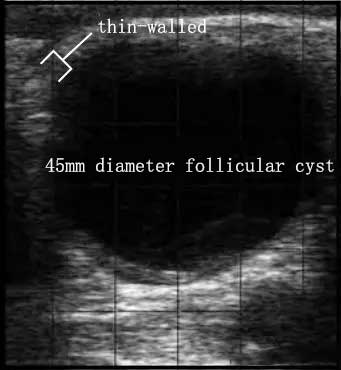Bovine ultrasound machine is a common tool used in dairy reproduction management and is often used to identify pregnant and non-pregnant cows, and the bovine ultrasound machine does more than that. Ovarian cysts (OC) in dairy cows are an important ovarian dysfunction and a major cause of reproductive failure in dairy cows, and ultrasound testing can easily distinguish them.
Although transrectal palpation has long been the diagnostic method, follicular cysts cannot be distinguished from luteal cysts by palpation alone. In cows not in heat, it is difficult to distinguish follicular cysts from luteal cysts without the use of a bovine ultrasound machine. A combination of transrectal palpation of the genital tract to determine luteal absence and lack of uterine tone may improve accuracy in diagnosing ovarian cysts and distinguishing follicular from luteal cysts; ultrasonography to confirm the absence of the corpus luteum, to determine the size of follicles that are present, and to check for corpora lutea; and measurement of plasma luteinizing hormone concentration to determine the degree of luteinization.
Diagnostic accuracy can be improved by obtaining information about the animal’s reproductive history, vaginal examination, and progesterone measurement. Some cows may exhibit a normal estrous cycle, although they may have one or more cysts in one or both ovaries. Luteal cysts are described as enlarged ovaries with one or more cysts that have thicker walls than follicular cysts due to the lining of luteal tissue. Ultrasonography is effective in detecting follicular and corpus luteum cysts with high precision. Veterinary color Doppler ultrasonography is superior to B/W ultrasonography in differentiating between follicular and corpus luteum cysts and aids in the selection of treatment. However, the use of veterinary color Doppler ultrasonography does not accurately predict the regression or persistence of ovarian cysts and the response of ovarian cysts to GnRH analog therapy.

Two approaches can be considered for the diagnosis of ovarian cysts. First, multiple follicles approximately 18 to 20 mm in diameter are examined, and second, ovarian follicular waves are examined over a 7- to 10-day period in the absence of ovulation, corpus luteum, and uterine tone. Determining the presence or absence of follicular waves during the 7- to 10-day period when follicles reach ovulatory size (12 mm) can be used to retrospectively distinguish ovarian cysts from shallow trophic arrest with low BCS. In general, corpus luteum cysts are associated with relatively high concentrations of progesterone in the peripheral circulation, whereas follicular cysts are associated with relatively low concentrations of progesterone. They should not be confused with hollow corpus luteum, which is not pathognomonic at all. Therefore, accurate diagnosis of the type of ovarian cyst requires a combination of diagnostic methods, such as transrectal palpation and transrectal ultrasonography.
Post time: Apr-08-2024



